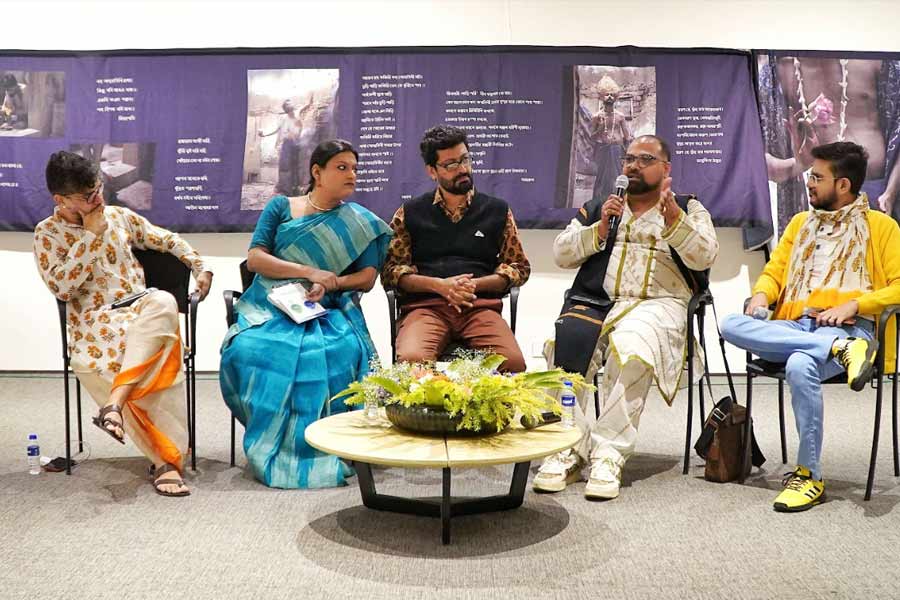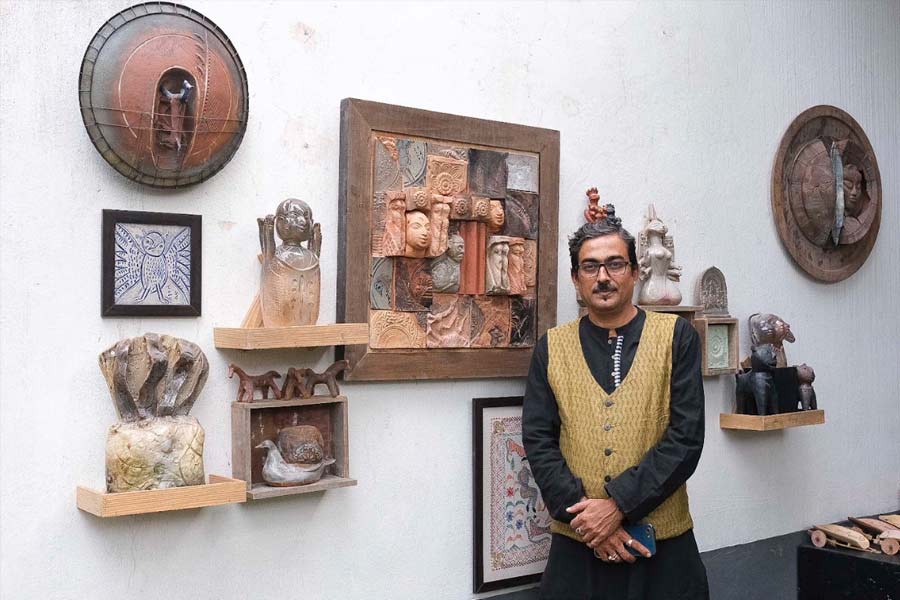“Six yards of fabric — sometimes woven with the cheapest of yarns and sometimes with the rarest of silks — is seldom just a garment.” These words by human rights lawyer Debjyoti Ghosh expand the perception of the ‘sari’ in Kolkata Centre for Creativity’s (KCC) latest exhibition held on December 3 and 4. Titled Queering the Six Yards, the exhibit aims to look at this iconic piece of clothing beyond the shackles of genre, class or caste, as a part of KCC’s ongoing AMI Arts Festival.

The event started off with a discussion on Undoing Gender with Pride, moderated by curator (extreme left) Debjyoti Ghosh. The panel comprised (L-R) Anurag Maitreyee, Bhaskar Chaudhuri, Debanuj Dasgupta and Kaustav Bakshi
Curated by Ghosh, the exhibition documented the sari’s journey from a daily essential to a companion for special occasions, and its evolution into a marker not just of wealth and social status but also of the nationalism.
The exhibit commenced with a thought-provoking panel discussion, titled ‘Undoing Gender with Pride’. Ghosh moderated the panel, aand the speakers included trans activist Anurag Maitreyee; Kaustav Bakshi, associate professor at Jadavpur University; Debanuj Dasgupta, associate professor at the University of California, Santa Barbara and Bhaskar Chaudhuri, associate professor at Serampore College.

One of the chief inspirations behind the exhibit was Vqueeram Aditya Sahai’s project, ‘Mummy ki Sari’, which encourages mothers to pass on their saris to trans and gender non-conforming individuals
Ghosh acknowledged how much the needle had been pushed in the past decade by drawing attention to the very fact that such a discussion was happening in KCC. “10 years ago, there would have been very few spaces that would accommodate a discussion like this, let alone welcome someone with a beard, wearing a sari. Our work constantly strives to break notions that gatekeeper clothes, and allows or disallows us based on what we wear.”
Bakshi added that male gaze was a relatively recent phenomenon, sprinkled into Indian society by colonial powers rather than emerging from within. “As homo sapiens, clothing emerged to protect the body from the weather, not out of an idea of modesty or privacy. Even in the Mahabharata and Ramayana, clothing was referred to in gender-neutral terms,” he said. Chaudhuri also pointed out that even within the country, apparel changes course dramatically, decimating any centralised gender norms. “In North India, men wear kurta-pyjamas, while in Bengal a dhuti is extremely fashionable. Down South, a dhoti is used as a lungi!”

Each of the saris at the exhibit told a profound story. The sari on the left was contributed by Ananya Som, who received it from her grandmother during Durga Puja, and wore it the day she started their transition. The one on the right was custom made by ‘onno rokom’ to mirror the cover of a book written by Bonnya
Dasgupta argued that the contemporary idea of masculinity was constructed by negating femininity, without considering what masculinity represented on its own. “Hinduism needs blood to be pure in order to maintain caste, and hence it controls reproduction. Gender is a by-product of controlling reproduction in South Asia. I picked my mother’s saris and not my domestic help’s because I too am reproducing caste and class,” he confessed.
Maitreyee brought her lived experience as a transwoman into the discussion, shedding light on the struggle to wear what they want while fighting against heteropatriarchal notions. “As a child, even before I knew terms like queer or trans, I knew that I felt out of place in the clothes given to me. When Ma left, I would secretly wear her clothes and admire myself in the mirror,” she reminisced.
The integral association between the sari and maternal love was also discussed. “A sari is automatically equated with maternal love and ma’s anchal, which instils a certain power within it. Men often assume that someone is more of a woman if they wear a sari, but my identity as a woman shouldn’t be any less if I wear jeans and a top,” Maitreyee added. Ghosh also remarked, “I’m wearing my mother’s sari today as a dhuti.”
Chaudhuri and Bakshi also shared some anecdotes of the legendary Rituparno Ghosh and his exploration of appearance with gender. “Rituda and I once wore kajal and went to watch a Salman Khan film, not because it was gendered, but because of its importance within the community. It truly furthered our understanding of how fashion has so many identity based markers,” Bakshi smiled. In response, Chaudhuri recounted his collaboration with the legendary director during the pre-production of Chokher Bali, “Rituda spent a great deal of time questioning how Binodini’s character should wear a sari after being widowed, given that she came from a village but had an English education. So much thought eventually went into establishing that she didn’t wear a blouse, but wanted to wear a red one.”

This artwork by Sanidhya Dutta represents an intimate conversation between him and the mirror, where he gazes at his distorted reflection dressed in a vibrant red sari
Besides this, the exhibition comprised multimedia art, photographs, and archival material on the journey of the queer movement, along with saris collated from organisations and individuals.
“I first conceptualised this exhibit in 2019, when I got to know about Vqueeram Aditya Sahai’s Mummy ki Sari (Mother’s Sari) collection. It has become a motif for those who are deprived of maternal affection, and is demonstrative of how the sari helps understand the journey of queer people and how it has become this new form of resistance,” signed off Ghosh.


